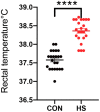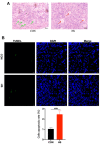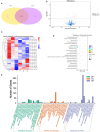Negative effects of heat stress on ovarian tissue in female rabbit
- PMID: 36452142
- PMCID: PMC9704112
- DOI: 10.3389/fvets.2022.1009182
Negative effects of heat stress on ovarian tissue in female rabbit
Abstract
Numerous studies have highlighted the role of miRNA in the deformation and necrosis of cells of ovarian tissue caused by heat stress (HS), which ultimately affects ovarian function. Although the role of small RNAs has been investigated in alterations in ovarian tissue functioning in response to HS, the expression profile of ovarian miRNA has been explored to a lesser extent. In this study, female rabbits were subject to HS treatment by using electrical heater. The current work demonstrated that HS could significantly change physiological performance of female rabbits including body weight, rectal temperature and relative ovary weight, and significantly reduce serum IL-2, IL-8, CAT, and GSH-Px concentrations by enzyme-linked immunosorbent assay (ELISA) technique. As a result, an increase in apoptosis in ovarian cells, as well as unhealthy follicles, were observed by Hematoxylin-eosin (HE) and TUNEL staining. Additionally, small RNA-seq revealed changes in the miRNA expression profile of rabbit ovaries under HS. Five hundred fourteen miRNAs were obtained including known miRNAs 442 and novel miRNAs 72. Among these miRNAs, 23 miRNAs were significantly expressed under HS. Eleven differentially expressed miRNAs (DE miRNAs) and 9 their predicted targets were confirmed by qPCR, which were expected miRNA-mRNA negative regulation pattern. Among the DE miRNAs and targets, miR-141-39 may target COQ6, miR-449a-5p and miR-34c-5p may control RFC5 and RTN2 together, miR-449a-5p may target ACADVL, miR-34c-5p potentially targets Bcl-2 and miR-196b-5p potentially regulates CASK and HOXB6. Thus, the current work suggested the negative effects of HS on the ovarian tissue of female rabbits, and in conclusion these changes could be caused by decreased serum IL-2, IL-8, CAT and GSH-Px levels, increased ovarian apoptosis, and changed the expression of miRNAs.
Keywords: gene expression; heat stress; microRNA; ovary; rabbit.
Copyright © 2022 Tang, Bai, Xie, Chen, Jia, Lei, Li and Lai.
Conflict of interest statement
The authors declare that the research was conducted in the absence of any commercial or financial relationships that could be construed as a potential conflict of interest.
Figures





Similar articles
-
Vitamin D deficiency inhibits microRNA-196b-5p which regulates ovarian granulosa cell hormone synthesis, proliferation, and apoptosis by targeting RDX and LRRC17.Ann Transl Med. 2021 Dec;9(24):1775. doi: 10.21037/atm-21-6081. Ann Transl Med. 2021. PMID: 35071469 Free PMC article.
-
Global miRNA expression analysis of serous and clear cell ovarian carcinomas identifies differentially expressed miRNAs including miR-200c-3p as a prognostic marker.BMC Cancer. 2014 Feb 11;14:80. doi: 10.1186/1471-2407-14-80. BMC Cancer. 2014. PMID: 24512620 Free PMC article.
-
Peritoneal fluid modifies the microRNA expression profile in endometrial and endometriotic cells from women with endometriosis.Hum Reprod. 2015 Oct;30(10):2292-302. doi: 10.1093/humrep/dev204. Epub 2015 Aug 25. Hum Reprod. 2015. PMID: 26307093
-
Downregulations of miR-449a and miR-145-5p Act as Prognostic Biomarkers for Endometrial Cancer.J Comput Biol. 2020 May;27(5):834-844. doi: 10.1089/cmb.2019.0215. Epub 2019 Sep 12. J Comput Biol. 2020. PMID: 31513434
-
miR-196b targets c-myc and Bcl-2 expression, inhibits proliferation and induces apoptosis in endometriotic stromal cells.Hum Reprod. 2013 Mar;28(3):750-61. doi: 10.1093/humrep/des446. Epub 2013 Jan 4. Hum Reprod. 2013. PMID: 23293219
Cited by
-
Negative effect of seasonal heat stress on testis morphology and transcriptomes in Angora rabbit.BMC Genomics. 2025 May 14;26(1):478. doi: 10.1186/s12864-025-11659-x. BMC Genomics. 2025. PMID: 40369431 Free PMC article.
-
miR-196a Promotes Proliferation of Mammary Epithelial Cells by Targeting CDKN1B.Animals (Basel). 2023 Nov 28;13(23):3682. doi: 10.3390/ani13233682. Animals (Basel). 2023. PMID: 38067033 Free PMC article.
-
Physio-metabolic response, immune function, epigenetic markers, and reproductive performance of rabbits under environmental stress: the mitigating role of boswellia essential oil nanoemulsion.BMC Vet Res. 2025 Mar 15;21(1):168. doi: 10.1186/s12917-025-04587-1. BMC Vet Res. 2025. PMID: 40087761 Free PMC article.
-
Impact of Heat Stress on Oocyte Developmental Competence and Pre-Implantation Embryo Viability in Cattle.Animals (Basel). 2024 Aug 5;14(15):2280. doi: 10.3390/ani14152280. Animals (Basel). 2024. PMID: 39123806 Free PMC article. Review.
-
Ramifications of Heat Stress on Rabbit Production and Role of Nutraceuticals in Alleviating Its Negative Impacts: An Updated Review.Antioxidants (Basel). 2023 Jul 11;12(7):1407. doi: 10.3390/antiox12071407. Antioxidants (Basel). 2023. PMID: 37507946 Free PMC article. Review.
References
-
- Abbas MA, Alqaisi KM, Disi A, Hameed NA. Chrysin increased progesterone and LH levels, estrous phase duration and altered uterine histology without affecting aromatase expression in rat ovary. J Funct Foods. (2022) 89:104964. 10.1016/j.jff.2022.104964 - DOI
-
- Yasoob TB, Yu D, Khalid AR, Zhang Z, Zhu X, Saad HM, et al. . Oral administration of Moringa oleifera leaf powder relieves oxidative stress, modulates mucosal immune response and cecal microbiota after exposure to heat stress in New Zealand White rabbits. J Anim Sci Biotechnol. (2021) 12:1–15. 10.1186/s40104-021-00586-y - DOI - PMC - PubMed
LinkOut - more resources
Full Text Sources
Research Materials
Miscellaneous

